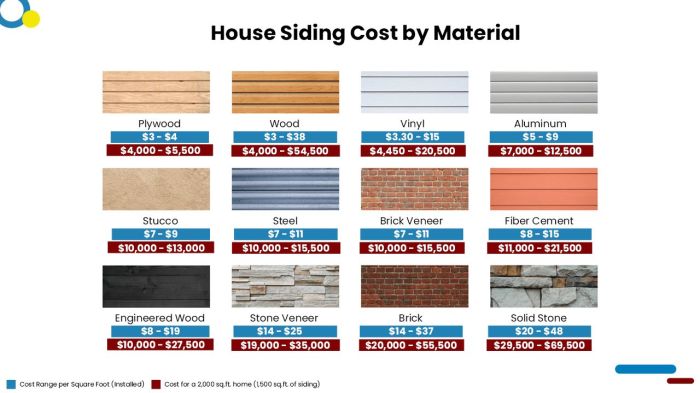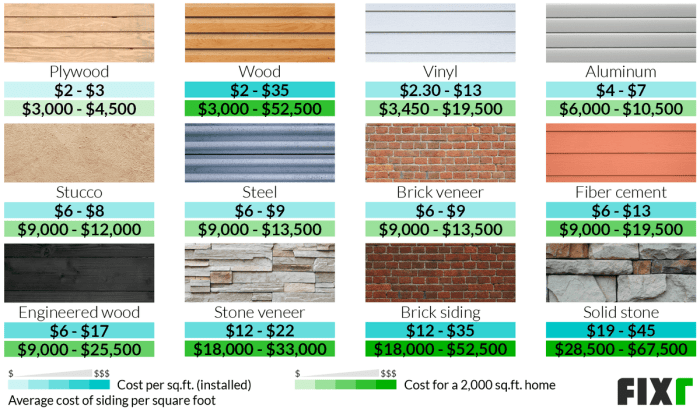Exploring the Average Cost for New Siding: Factors, Variations, and Strategies
Delving into the realm of average cost for new siding, this introduction aims to provide a comprehensive overview that sheds light on the key aspects affecting pricing and installation.
As we navigate through the intricacies of siding materials, regional disparities, cost-effective strategies, and additional expenses, a clearer picture emerges of the financial considerations involved in revamping your home's exterior.
Factors influencing the average cost for new siding
When considering the average cost for new siding, several factors come into play that can influence the total expense. Understanding these factors is crucial in making informed decisions about your siding project.
Types of siding materials and their cost implications
Different types of siding materials come with varying price points. For example, vinyl siding is generally more affordable compared to fiber cement or wood siding. The material you choose will significantly impact the overall cost of your project.
Size of the house affecting the overall cost of siding
The size of your house plays a significant role in determining the cost of siding. Larger homes will require more materials and labor, leading to higher expenses. It's essential to consider the square footage of your house when estimating the total cost.
Complexity of the installation process impacting pricing
The complexity of the installation process can also affect the pricing of new siding. Factors such as architectural details, obstacles like chimneys or windows, and the need for additional preparation work can all contribute to higher labor costs. A more intricate installation will likely result in a higher overall expense.
Comparison of labor costs versus material costs in determining the total expense
Labor costs and material costs are two significant components that make up the total expense of new siding. While materials account for a substantial portion of the budget, labor costs can also vary depending on the complexity of the project and the expertise of the contractors involved.
It's essential to compare both aspects to get a clear picture of the total expense involved in your siding project.
Regional variations in the cost of new siding

When it comes to the cost of new siding, regional variations play a significant role in determining the overall pricing of siding projects. Factors such as location, local regulations, building codes, urban versus rural areas, and climate conditions can all influence how much you might pay for your new siding.
Location Impact on Siding Pricing
The location of your property can greatly impact the cost of new siding. In areas where materials need to be transported over long distances, you may incur higher shipping costs, leading to an increase in overall project expenses. Additionally, areas with higher demand for siding services may have higher labor costs, further driving up the price.
Local Regulations and Building Codes
Local regulations and building codes can also affect the cost of new siding. Some regions may have specific requirements for the type of siding materials that can be used, which may be more expensive than standard options. Compliance with these regulations may require additional time and resources, ultimately impacting the overall cost of the project.
Urban vs Rural Areas
Urban areas tend to have higher labor costs and more competition among contractors, which can drive up the price of siding projects. On the other hand, rural areas may have lower labor costs but higher transportation fees for materials. Considering these factors, the cost of new siding can vary significantly between urban and rural locations.
Impact of Climate Conditions
Climate conditions can impact the longevity of siding and overall project costs. Harsh weather conditions, such as extreme heat, cold, or humidity, can cause siding materials to deteriorate more quickly, leading to higher maintenance and replacement costs over time. Choosing durable materials that can withstand local climate conditions is essential to ensure the longevity of your siding and minimize long-term expenses.
Cost-effective strategies for installing new siding

When it comes to installing new siding, there are several cost-effective strategies that homeowners can consider to save money without compromising on quality.
Tips on choosing cost-effective siding materials
- Consider durable materials like vinyl or fiber cement that require minimal maintenance over time.
- Compare the initial cost of materials with their longevity to determine the best value for your budget.
- Explore options for recycled or eco-friendly siding materials that may be cost-effective in the long run.
Benefits of DIY installation versus hiring professionals
- DIY installation can save on labor costs but requires proper tools and expertise to ensure a quality finish.
- Hiring professionals guarantees a professional installation, but it comes at a higher cost.
- Consider your skill level and available time when deciding between DIY and professional installation.
Insights on negotiating prices with contractors for better deals
- Obtain multiple quotes from different contractors to compare prices and negotiate for discounts.
- Ask about any ongoing promotions or seasonal discounts that contractors may offer to reduce costs.
- Be willing to negotiate on the scope of work or materials to lower the overall cost of the project.
Compare long-term maintenance costs of different siding options for cost-effectiveness
- Consider the maintenance requirements of each siding material and factor in the cost of upkeep over time.
- Choose materials that are resistant to rot, pests, and weather damage to minimize long-term maintenance expenses.
- Look for warranties or guarantees on siding materials that can help offset future maintenance costs.
Additional costs associated with new siding projects
When embarking on a new siding project, it's crucial to consider the potential additional costs that may arise beyond the basic installation. These extra expenses can significantly impact the overall budget and should be factored in from the beginning to avoid any financial surprises along the way.It's important to note that trim work, insulation, and painting are common additional costs associated with new siding projects.
Trim work involves finishing the edges and corners of the siding for a polished look, while proper insulation helps improve energy efficiency and regulates indoor temperature. Painting the siding can also add to the aesthetic appeal and protection of the exterior of your home.Permits and inspection costs are another crucial consideration when installing new siding.
Depending on your location, you may need to obtain permits before starting the project, which can incur additional fees. Inspections may also be required at various stages of the installation process to ensure compliance with building codes and regulations.Unexpected repairs or structural issues can also impact the overall cost of a new siding project.
If underlying damage or issues are uncovered during the installation process, additional repairs may be necessary to ensure the longevity and structural integrity of the new siding. It's essential to budget for these potential expenses to avoid any delays or setbacks during the project.Furthermore, warranties and insurance are additional costs that may be worth considering to protect your investment in new siding.
Warranties can offer peace of mind by covering any defects or issues that may arise with the siding materials or installation. Insurance can provide added protection in case of accidents, damages, or other unforeseen events related to the siding project.
Examples of warranties and insurance that may add to the total cost
- Some siding manufacturers offer warranties on their products, ranging from 10 to 50 years, which may come at an additional cost but provide reassurance of quality and durability.
- Contractors may offer installation warranties, guaranteeing their work for a certain period, which can be beneficial in case of any installation-related issues post-completion.
- Adding insurance coverage for the siding project to your existing homeowners' insurance policy can protect you against potential liabilities, damages, or accidents during the installation process.
Final Wrap-Up
In conclusion, the average cost for new siding is a multifaceted subject that demands careful analysis and decision-making. By understanding the factors influencing pricing, exploring regional variations, and implementing cost-effective strategies, homeowners can embark on their siding projects with confidence and financial prudence.
Clarifying Questions
What are the most cost-effective siding materials?
Opt for vinyl or fiber cement siding for a balance between affordability and durability.
Is DIY installation recommended for new siding?
While it can save money, hiring professionals ensures a quality finish and avoids potential errors.
How can homeowners negotiate prices with contractors?
Obtain multiple quotes, compare offers, and leverage any existing relationships for better deals.
What additional costs should be considered for new siding projects?
Trim work, insulation, painting, permits, inspections, and potential repairs are all factors to budget for.
Do warranties and insurance impact the total cost of new siding?
Yes, warranties and insurance coverage can add to the overall expense but provide valuable protection and peace of mind.